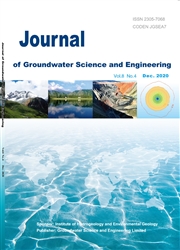Hydrogeochemical characteristics of hot springs exposed from fault zones in western Guangdong and their 14C age correction
作者:WANG Hua,MAO Xu-mei,WANG Tao,FENG Liang,LIANG Li-li,ZHU Dong-bo,YANG Kai-ming
摘要:Hot springs are natural exposed points of the hydrothermal system. The hydrogeochemistry of hot springs can be used to interpret the formation of the hydrothermal system;and the 14C dating can be used to evaluate the renewability of the hydrothermal system. The hot springs exposed from fault zones in western Guangdong are classified as granite fissure water and clastic rock fissure water, which are sampled and tested. The results of water chemistry analysis show that hot spring water is mainly HCO3-Na type in the beginning, while the mixing of seawater leads to the increase of Cl-. Hydrogen and oxygen isotopes indicate that these hot springs mainly come from atmospheric precipitation, and water-rock interactions produce oxygen isotope exchange reactions, where a significant “oxygen drift” phenomenon can be observed. The relationship between δ^13C and HCO3 - indicates that there is a deep source of CO2 “dead carbon” in hot spring water. This systematic error is not considered in the existing 14C dating correction models. The 14C age of the deep source “dead carbon” correction proposed in this paper is close to the 14C age of the reverse chemical simulation correction, the Gonfiantinie model, and the Mook model. The deep source “dead carbon” correction method can improve the systematic error. Therefore, the 14C age corrected by the deep source “dead carbon” may be more representative in terms of the actual age of geothermal water.
发文机构:School of Architecture and Civil Engineering School of Environmental Studies
关键词:HYDROGEOCHEMISTRY14CageDeepsource“deadcarbon”HotspringWESTERNGUANGDONG
分类号: TV[水利工程]
- Aquifer hydraulic conductivity prediction via coupling model of MCMC-ANN
- Visualizing the spatial water quality of Bentota, Sri Lankain the presence of seawater intrusion
- Characteristics of the main inorganic nitrogen accumulation in surface water and groundwater of wetland succession zones
- Analysis of occurrence characteristics of geothermal resources and its relation to control structures in Zibo City, China
- Delineation of potential groundwater zones based on multicriteria decision making technique
- Foundation pit dewatering optimization design based on GMW-2005 and LGR technique
- Geological characteristics and analysis of hydrothermal genesis in the Suijiang-1 well in Yunnan Province, China
- Characteristics of karst groundwater system in the northern basin of Laiyuan Spring area
- Study on Jinan urban construction planning based on the protection of karst landscape
- Discussion on establishing monitoring networks for temperature fields of shallow thermal energy in Shandong, China


